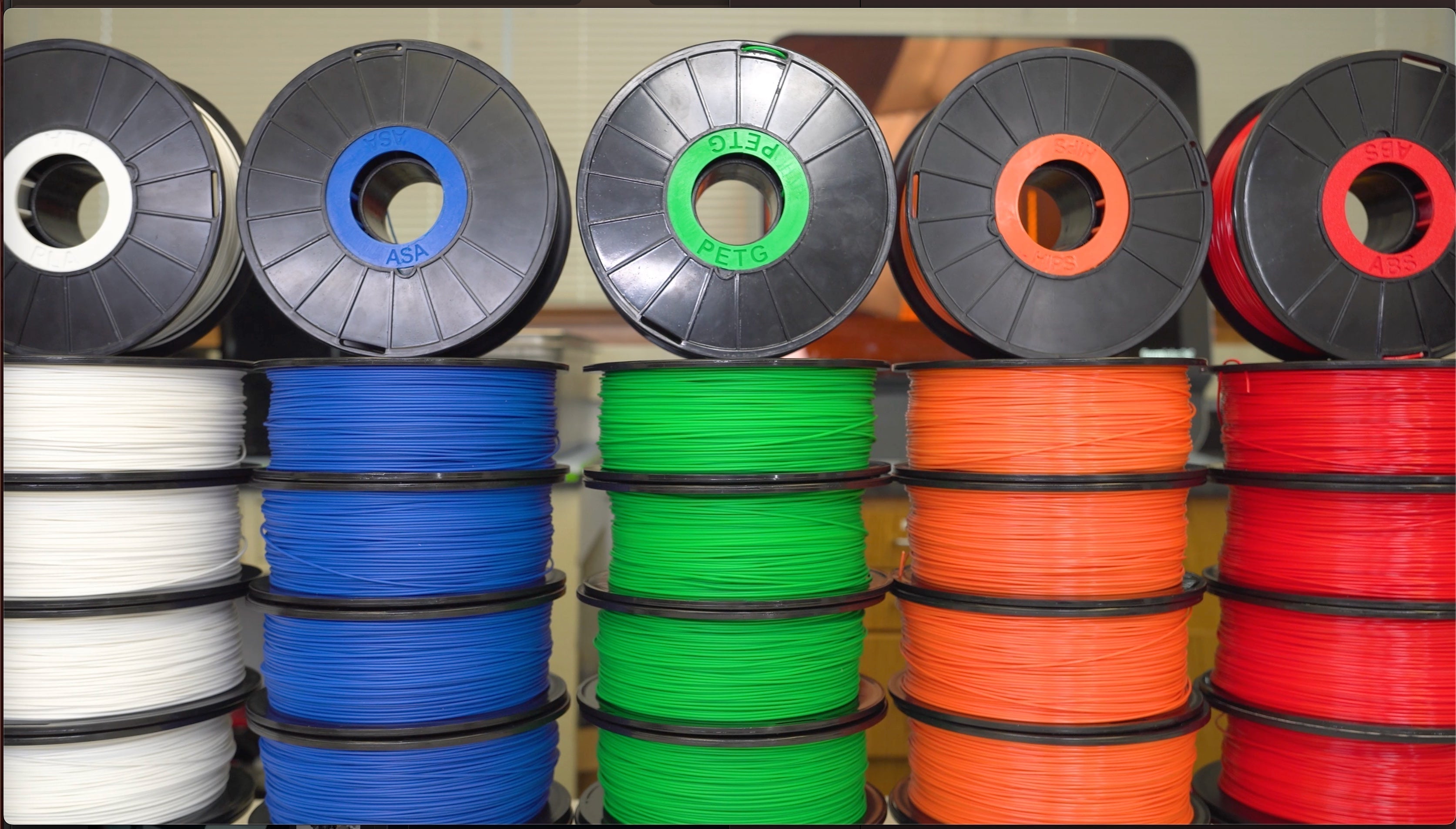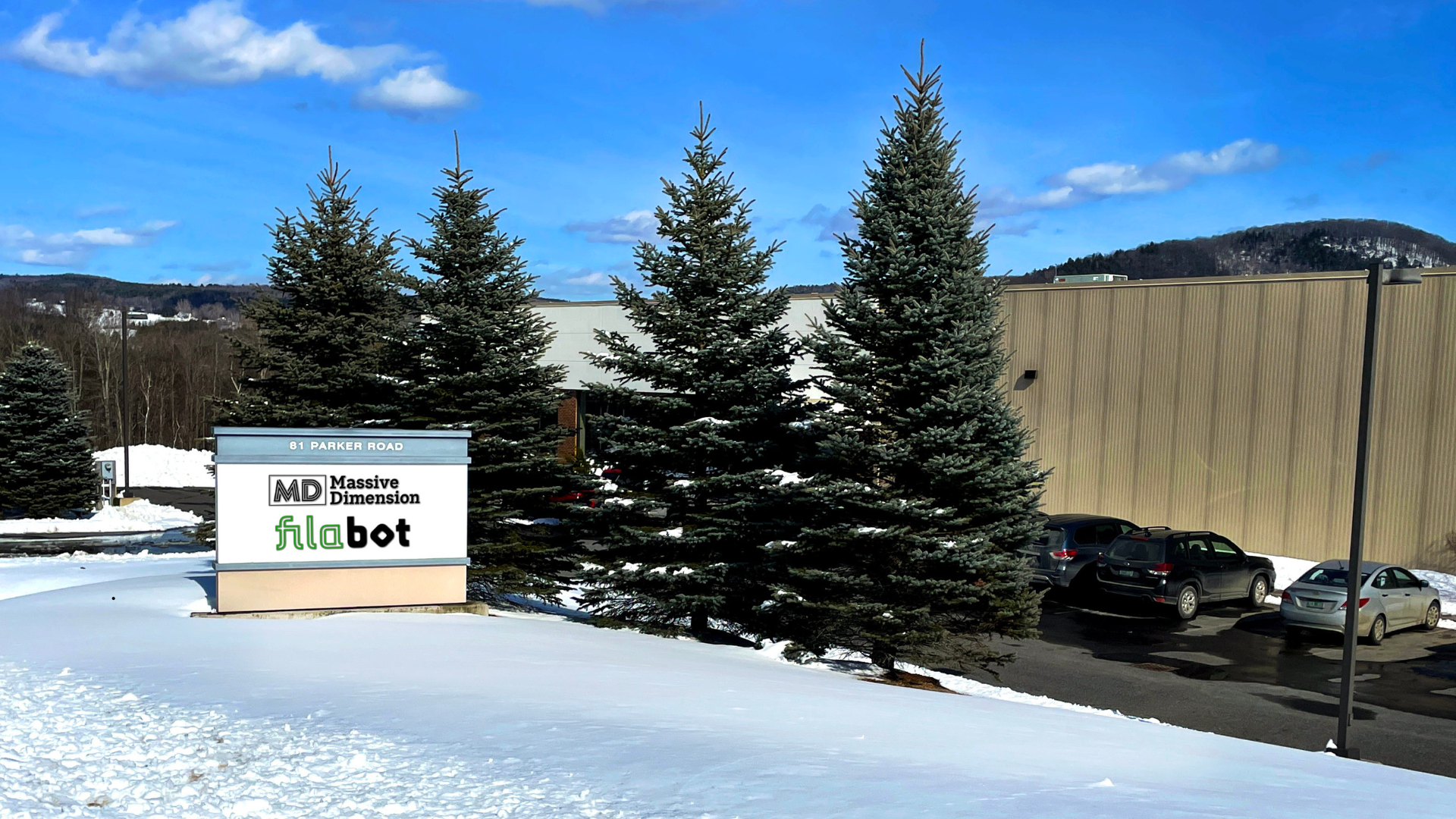Here is a comprehensive list of commonly used plastics for 3D printing, along with their key characteristics, print temperatures, heated bed requirements, and potential applications.
All of these materials are fully compatible with our EX6 Industrial Extruder.
1. PLA (Polylactic Acid)
-
Key Characteristics: Easy to print, low cost, industrially biodegradable, low warping, less durable than others.
-
Print Temp: 190–220°C
-
Heated Bed: Not required but recommended at 40–60°C
-
Uses: Prototyping, decorative items, models, toys, and low-strength applications.
PLA is a beginner-friendly, biodegradable plastic made from renewable resources like corn starch. It’s easy to print due to its low warping and wide availability, making it ideal for decorative models, prototypes, and non-functional items. The key benefit of PLA is its simplicity and environmental friendliness, but it lacks durability, heat resistance, and flexibility compared to other materials. It’s great for first-time users or projects that don’t require mechanical strength or exposure to high temperatures.
2. ABS (Acrylonitrile Butadiene Styrene)
-
Key Characteristics: Strong, durable, impact-resistant, prone to warping.
-
Print Temp: 220–250°C
-
Heated Bed: Required at 90–110°C
-
Uses: Automotive parts, tool housings, functional prototypes, and toys (e.g., LEGO bricks).
ABS is a strong, durable plastic known for its impact resistance and versatility, commonly used in automotive parts and toys like LEGO. It’s a step up from PLA, offering better mechanical properties, but it requires precise temperature control and a heated bed to combat warping. ABS emits fumes during printing, so proper ventilation is a must. It’s an excellent choice for functional prototypes and durable parts but may frustrate new users due to its sensitivity to printing conditions. (We do not recommend using Styrene based products for printing. When you heat Styrene it off-gasses which and these fumes are known carcinogens*)
3. PETG (Polyethylene Terephthalate Glycol)
-
Key Characteristics: Strong, chemical-resistant, slightly flexible, easy to print.
-
Print Temp: 215-230°C
-
Heated Bed: Recommended at 60–80°C
-
Uses: Food-safe containers, water bottles, mechanical parts, and outdoor applications.
PETG strikes a balance between ease of use and durability, offering strength, flexibility, and chemical resistance. It’s less prone to warping than ABS and more durable than PLA, making it suitable for food-safe containers, mechanical parts, and outdoor applications. While PETG is forgiving and doesn’t require an enclosed printer, it can string more than PLA and may be tricky for precise prints. It’s perfect for intermediate users seeking durable, functional prints without excessive difficulty.
4. TPU (Thermoplastic Polyurethane)
-
Key Characteristics: Flexible, rubber-like, abrasion-resistant.
-
Print Temp: 200–240°C
-
Heated Bed: Recommended at 40–60°C
-
Uses: Seals, gaskets, phone cases, wheels, and flexible connectors.
TPU is a flexible, rubber-like filament that’s highly durable and abrasion-resistant, making it ideal for phone cases, gaskets, and wheels. It challenges beginners because of its elasticity, which can cause issues with feeding and extrusion. However, once mastered, TPU enables unique applications that rigid plastics can’t achieve. New users should have a direct-drive extruder for easier handling and be patient with tuning their printer settings.
5. Nylon (Polyamide)
-
Key Characteristics: Strong, durable, wear-resistant, hygroscopic (absorbs moisture).
-
Print Temp: 240–270°C
-
Heated Bed: Required at 70–90°C
-
Uses: Gears, hinges, bearings, and durable mechanical parts.
Nylon is a tough, wear-resistant material known for its strength and durability. It’s ideal for gears, bearings, and functional parts subjected to stress or friction. Nylon’s key drawback is its high moisture absorption, which requires careful storage and drying before printing. Additionally, it demands higher print temperatures and a heated bed, making it better suited for advanced users. For functional applications requiring toughness, Nylon is a go-to material but requires skill to manage its challenges.
6. Polycarbonate (PC)
-
Key Characteristics: Extremely strong, impact-resistant, heat-resistant.
-
Print Temp: 260–300°C
-
Heated Bed: Required at 90–110°C
-
Uses: Functional prototypes, light diffusers, mold tooling, and engineering parts.
Polycarbonate is a premium material offering extreme strength, impact resistance, and heat resistance. It’s commonly used for engineering parts and functional prototypes in demanding environments. However, PC requires very high print temperatures and an enclosed printer to prevent warping, which makes it challenging for beginners. It’s a great option for experienced users needing ultra-tough parts, but its difficulty level and high cost may deter casual hobbyists.
7. ASA (Acrylonitrile Styrene Acrylate)
-
Key Characteristics: UV-resistant, durable, similar to ABS but more weatherproof.
-
Print Temp: 240–260°C
-
Heated Bed: Required at 80–100°C
-
Uses: Outdoor applications, automotive parts, and functional prototypes.
ASA is similar to ABS but offers superior UV resistance and weatherproofing, making it ideal for outdoor applications like automotive components and garden tools. Like ABS, it requires precise temperature control and emits fumes during printing, so an enclosed printer and ventilation are essential. ASA’s added durability and UV stability make it a good choice for functional parts exposed to sunlight, but its higher printing demands may challenge new users. (We do not recommend using Styrene based products for printing. When you heat Styrene it off-gasses which and these fumes are known carcinogens*)
8. HIPS (High Impact Polystyrene)
-
Key Characteristics: Strong, dissolvable in limonene, used as a support material for ABS.
-
Print Temp: 220–240°C
-
Heated Bed: Required at 90–110°C
-
Uses: Support structures, models, and lightweight parts.
HIPS is a strong yet lightweight material often used as a dissolvable support for ABS prints. It dissolves in limonene, making it ideal for complex models requiring clean support removal. HIPS prints similarly to ABS, requiring a heated bed and controlled environment to prevent warping. It’s perfect for dual-extrusion setups but less practical for beginners without a specific need for soluble supports. (We do not recommend using Styrene based products for printing. When you heat Styrene it off-gasses which and these fumes are known carcinogens)
9. PVA (Polyvinyl Alcohol)
-
Key Characteristics: Water-soluble, biodegradable, used as a support material.
-
Print Temp: 190–220°C
-
Heated Bed: Not required but recommended at 40–60°C
-
Uses: Dissolvable supports for dual-extrusion printers.
PVA is a water-soluble material primarily used as a support filament for complex dual-extrusion prints. It’s biodegradable and easy to dissolve, making it perfect for intricate designs. However, PVA is moisture-sensitive and must be stored carefully to prevent degradation. It’s not suitable for standalone prints and is best for users with dual-extrusion printers who need dissolvable supports for complex geometries.
10. PEEK (Polyether Ether Ketone)
-
Key Characteristics: High strength, chemical resistance, heat resistance, expensive.
-
Print Temp: 400-500°C
-
Heated Bed: Required at 120–160°C
-
Uses: Aerospace, medical implants, and high-performance engineering parts.
PEEK is a high-performance, industrial-grade material known for its exceptional strength, chemical resistance, and heat tolerance. Used in aerospace and medical applications, PEEK is one of the most advanced and expensive filaments. Printing PEEK requires very high temperatures and an advanced printer, making it inaccessible for most casual users. It’s reserved for professionals needing top-tier materials for demanding environments.
11. PEI (Polyetherimide, e.g., ULTEM)
-
Key Characteristics: High strength, heat resistance, flame retardant.
-
Print Temp: 350–400°C
-
Heated Bed: Required at 120–160°C
-
Uses: Electronics, automotive parts, and high-strength prototypes.
PEI is another high-performance engineering plastic offering excellent strength, heat resistance, and flame retardancy. Like PEEK, it’s expensive and requires high print temperatures and an enclosed environment. PEI is used for electronics, automotive, and aerospace parts. It is suited for professional users with specialized needs, but its cost and difficulty make it impractical for hobbyists.
12. Carbon Fiber-Filled Filaments (PLA, ABS, PETG, PC, PEI, Nylon base)
-
Key Characteristics: Lightweight, rigid, increased strength, abrasive, warp-resistant
-
Print Temp: Depends on base material (typically +10–20°C)
-
Heated Bed: Often not required thanks to decreased warping
-
Uses: Drone frames, structural parts, and automotive components.
Carbon fiber-filled filaments (e.g., PLA, ABS, PETG, or Nylon bases) are reinforced with carbon fibers for added strength, stiffness, and lightweight properties. These filaments are abrasive, requiring a hardened nozzle, but they produce extremely rigid parts with excellent dimensional stability. They’re ideal for drone frames, automotive components, and structural applications. Beginners should be cautious with abrasive wear on their printer components.
13. Wood-Filled PLA
-
Key Characteristics: Aesthetic clay-like finish and texture, easy to print.
-
Print Temp: 190–220°C
-
Heated Bed: Not required but recommended at 40–60°C
-
Uses: Decorative items, sculptures, and artistic models.
Wood-filled PLA blends PLA with wood fibers, creating prints with a unique aesthetic and a wood-like texture. It’s easy to print and works well for decorative objects and artistic models. However, the wood fibers can clog nozzles if not properly maintained, and prints are less durable than standard PLA. It’s a fun material for hobbyists seeking creative, visually appealing results.
14. Metal-Filled Filaments (PLA, PETG base)
-
Key Characteristics: Heavy, metallic finish
-
Print Temp: Depends on base material
-
Heated Bed: Based on base material
-
Uses: Jewelry, decorative objects, and art projects.
Metal-filled filaments contain metal powders mixed with a base like PLA or PETG, producing heavy, metallic-looking prints. They’re abrasive and require a hardened nozzle but create stunning decorative or artistic pieces. While not true metal parts, these filaments give prints an authentic metallic finish, making them popular for jewelry, replicas, and art projects. Beginners should focus on proper printer maintenance to avoid issues with nozzle wear.
15. PP (Polypropylene)
-
Key Characteristics: Flexible, lightweight, chemical-resistant. Hydrophobic
-
Print Temp: 200-220°C
-
Heated Bed: Not required
-
Uses: Food containers, automotive parts, and packaging.
Polypropylene is a lightweight, flexible, and chemical-resistant material often used in food containers and automotive parts. It’s challenging to print due to poor bed adhesion and warping but offers excellent durability and low friction. For advanced users, PP is ideal for functional parts that need flexibility and resilience. Beginners may struggle with its printability but can experiment with specialized adhesives for better results.
16. PC-ABS (Polycarbonate-ABS Blend)
-
Key Characteristics: Combines strength of PC and flexibility of ABS, impact-resistant.
-
Print Temp: 240–270°C
-
Heated Bed: Required at 100–120°C
-
Uses: Functional prototypes, automotive parts, and durable enclosures.
PC-ABS combines the toughness of polycarbonate with the flexibility and ease of ABS, offering a great balance of strength and printability. It’s impact-resistant and heat-tolerant, making it suitable for functional prototypes and enclosures. Like ABS, it requires a heated bed and a controlled printing environment. This blend is perfect for experienced users seeking durable parts with manageable printing requirements.
17. Glass Fiber-Filled Filaments (PLA, ABS, PETG, PC, PEI, Nylon base)
-
Key Characteristics: Good damping qualities, rigid, increased strength, abrasive, warp-resistant
-
Print Temp: Depends on base material (typically +10–20°C)
-
Heated Bed: Often not required thanks to decreased warping
-
Uses: Drone frames, structural parts, and automotive components.
Glass fiber-filled filaments are reinforced with finely chopped glass fibers, significantly increasing strength, rigidity, and dimensional stability while reducing warping. Available with various base polymers like PLA, ABS, PETG, PC, PEI, and Nylon, these composites retain the key properties of the base material while enhancing mechanical performance. For example, glass fiber-filled PLA is stronger and stiffer than regular PLA while remaining relatively easy to print, whereas glass fiber-filled Nylon provides exceptional strength and wear resistance for industrial-grade parts. The main drawback of these filaments is their abrasive nature, which requires a hardened nozzle to prevent wear, and their increased brittleness compared to unfilled versions. They’re ideal for functional parts like automotive components, structural prototypes, and tools, but new users must be prepared for slightly more challenging print settings and nozzle maintenance.
*To safely 3D print with styrene plastics, like ABS (acrylonitrile butadiene styrene) or ASA (acrylonitrile styrene acrylate), always ensure you have good ventilation by printing in a well-ventilated area or using an enclosed printer with an exhaust system to minimize exposure to potentially harmful styrene fumes released during the printing process; consider wearing a respirator mask when necessary and follow proper safety guidelines for handling chemicals.



